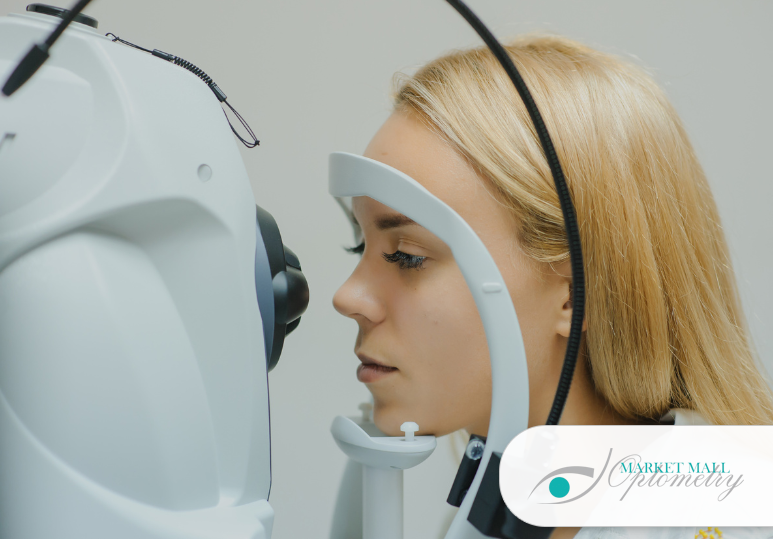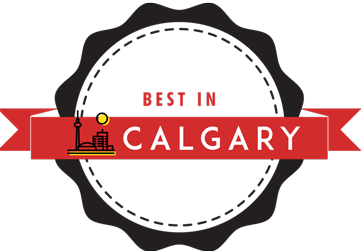What Is Assessed At An Eye Exam?
Visual Acuity
A person’s visual acuity is the measure of how well they can focus on an object and it is what determines your prescription. Visual acuity tests are conducted to assess refractive errors such as myopia (nearsightedness) and hyperopia (farsightedness), among others. An optometrist will measure your visual acuity through a series of visual tests and by looking at the shape of the eye itself. To test your visual acuity, you will be asked to read letters from a Snellen chart, which is the chart that shows rows of letters that get progressively smaller. Your optometrist will likely also use a phoropter to determine your correct prescription. This is the device you look through while your optometrist alternates between lenses and asks you which option is more clear. Visual acuity tests are always performed at eye exams and they are vital for maintaining optimal vision.
Eye Disease
There are many types of eye disease that your optometrist will check for, and there are several signifiers they will look for, including:
- Eye Pressure. The optometrist typically uses a tonometry test to check the pressure of the eye. While there are several forms of this test, the most common one uses a small puff of air to momentarily flatten the cornea and measure eye pressure. If the eye pressure seems high, other tests may be administered. Elevated eye pressure is one of the main signs of glaucoma, which is a group of eye conditions that cause damage to the optic nerve and can lead to permanent vision impairment. Checking for eye pressure during an eye exam can help to detect glaucoma early and halt its progression.
- Retinal Health. An optometrist will check your retinal health through visual tests that allow them to clearly see the back of the retina. This can include a direct examination or slit lamp examination, when your optometrist will shine a light into the eye that allows them to view the retina, but a retinal check can also include retinal imaging, where a photo is taken of the back of the eye so the optometrist can clearly see the retina and optic disk. For a retinal exam, dilating drops may be used to expand the pupil to give the optometrist a better view of the retina. Optometrists check retinal health to look for eye diseases such as age-related macular degeneration (AMD), diabetic eye disease, glaucoma, and hypertensive retinopathy.
- Blood Vessel Health. This is related to your retinal health, as the blood vessels in your retina are vital to healthy eyes. High blood pressure in the eyes can damage the blood vessels in the retina which can impair vision and cause headaches, damage to the optic nerve and central area of the retina, or bleeding in the back of the eye.
- Eye Movement. When an optometrist asks you to follow their finger, an image, or a light with your eye, they are testing your eye movement. If you are unable to follow the movement, there may be an issue with your eye muscles or your muscular coordination.
Adult Eye Exams At Market Mall Optometry In NW Calgary
Since many eye conditions do not present symptoms until after they are advanced, an adult eye exam is the only way to stay informed about your eye health. To check your eye health and prevent the development of eye conditions, schedule an adult eye exam with a Calgary optometrist at Market Mall Optometry. Our highly knowledgeable staff and experienced Calgary optometrists can help you understand your ocular health and how to continue maintaining your vision or what steps to take next if you are diagnosed with an eye condition. To schedule an adult eye exam at Market Mall Optometry, either call 1-403-286-4884 or fill out the contact form.
FAQ
Q: How often should I have an eye exam?
A: Adult eye exams are recommended once every two years, once a year for those over 65.
Q: What should I bring to my eye exam?
A: If you’re scheduled for an appointment at our eye clinic in Market Mall, coming prepared to your appointment can help us better meet your eye care needs. You should bring:
- Any prescription glasses, sunglasses, and contact lenses
- Any eye drops you are using
- Any medications and supplements
- A family history of significant medical conditions
- Your vision insurance information
- A record of recent eye injuries or surgeries
Q: Are comprehensive eye exams uncomfortable?
A: A comprehensive eye exam is non-invasive so you will not feel any pain or discomfort for the duration of the exam.





